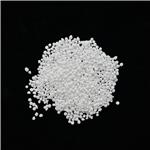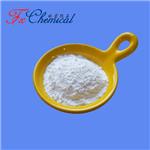Stearyl alcohol, or 1-octadecanol, is an organic compound classified as a saturated fatty alcohol with the formula CH3(CH2)16CH2OH. It occurs as hard, white, waxy pieces, flakes, or granules, which have a slight characteristic odor and a bland taste. It is soluble in alcohol, acetone, and ether, but insoluble in water. Furthermore, it is combustible.
1-Octadecanol is used as a surfactant in cosmetics. It effectively moisturizes hands and face with pheohydrane, which is a complex derived from the microalgae Chlorella Vulgaris and hydrolyzed algin found in sea water. It is a saturated alcohol of high purity and can substitute for cetyl alcohol in pharmaceutical dispensing, in cosmetic creams, for emulsions, textile oils and finishes, as antifoam agent, lubricant, viscosity agent, builder, and chemical raw material.
1-Octadecanol is prepared commercially via Ziegler aluminum alkyl hydrolysis or the catalytic, high-pressure hydrogenation of stearyl acid, followed by filtration and distillation. It may also be derived from natural fats and oils.
1-Octadecanol is a long chain primary alcohol that is used in the production of emulsions, textile oils, antifoam agents, and lubricants. Other large scale applications include the manufacture of alkyl amines, tertiary amines, ethoxylates, halides/mercaptans, and polymerization stabilizers. It generally occurs as a mixture of solid alcohols whose primary constituent is 1-octadecanol. It occurs naturally in sperm whale oil and has been isolated from the hyperthermophilic bacterium Pyrococcus furiosus.
1-Octadecanol has been used to model the plant epicuticular wax layer for an investigation by differential scanning calorimetry and Fourier transform infrared spectroscopy.
The use of 1-octadecanol to prepare microsphere formulations for such compounds as paclitaxel and indomethacin has been described.
Historically, stearyl alcohol was prepared from sperm whale oil but
is now largely prepared synthetically by reduction of ethyl stearate
with lithium aluminum hydride.
ChEBI: Octadecan-1-ol is a long-chain primary fatty alcohol consisting of a hydroxy function at C-1 of an unbranched saturated chain of 18 carbon atoms. It has a role as a plant metabolite, a human metabolite and an algal metabolite. It is a long-chain primary fatty alcohol, a fatty alcohol 18:0 and a primary alcohol. It derives from a hydride of an octadecane.
Mixed monolayers of 1-octadecanol and ethylene glycol monooctadecyl ether were studied to investigate their evaporation suppressing performance. The rate dependence of the collapse pressure for an octadecanolmonolayer using axisymmetric drop shape analysis has been investigated.
Mildly toxic by ingestion. Questionable carcinogen with experimental neoplastigenic data. A skin and eye irritant.
Flammable when exposed to heat or flame; can react with oxidizing materials. To fight fire, use foam, CO2, dry chemical. When heated to decomposition it emits acrid smoke and irritating fumes.
Flammability and Explosibility
Not classified
Pharmaceutical Applications
1-Octadecanol is used in cosmetics and topical pharmaceutical creams and ointments as a stiffening agent. By increasing the viscosity of an emulsion, stearyl alcohol increases its stability. 1-Octadecanol also has some emollient and weak emulsifying properties, and is used to increase the water-holding capacity of ointments, e.g. petrolatum. In addition, 1-Octadecanol has been used in controlled-release tablets, suppositories, and microspheres.It has also been investigated for use as a transdermal penetration enhancer.
Stearyl alcohol is generally considered to be an innocuous, nontoxic
material. However, adverse reactions to stearyl alcohol present in
topical preparations have been reported. These include contact
urticaria and hypersensitivity reactions, which are possibly due to
impurities contained in stearyl alcohol rather than stearyl alcohol
itself.
The probable lethal oral human dose is greater than 15 g/kg.
LD50 (rat, oral): 20 g/kg
1-Octadecanol is synthesized from Stearic acid, which may be obtained by saponification of Tallow, or hydrogenation of Cottonseed oil, from Castor oil or from other natural oils.
Stearyl alcohol is stable to acids and alkalis and does not usually
become rancid. It should be stored in a well-closed container in a
cool, dry place.
Crystallise octadecanol from MeOH, or dry Et2O and *C6H6, then fractionally distil it in vacuo. Also purify it by column chromatography. Free it from cetyl alcohol by zone refining. [Beilstein 1 IV 1888.]
Incompatible with strong oxidizing agents and strong acids.
[1] P. SELVIN THOMAS. Electrical properties of natural rubber nanocomposites: effect of 1-octadecanol functionalization of carbon nanotubes[J]. Journal of Materials Science, 2011. DOI:
10.1007/s10853-011-6174-4[2] DIANA N. H. TRAN. Molecular Interactions behind the Synergistic Effect in Mixed Monolayers of 1-Octadecanol and Ethylene Glycol Monooctadecyl Ether[J]. The Journal of Physical Chemistry B, 2013. DOI:
10.1021/jp401027c[3] Rowe, R.C., Sheskey, P.J., & Quinn, M. (1994). Handbook of Pharmaceutical Excipients.



